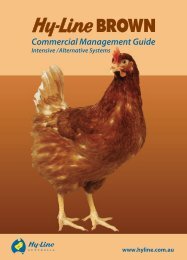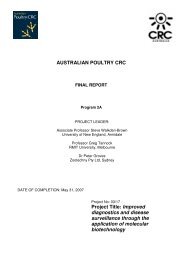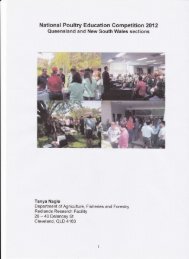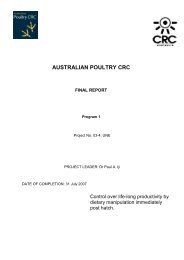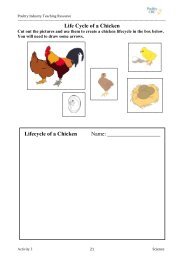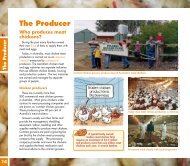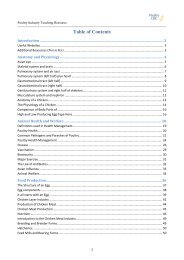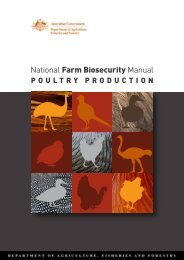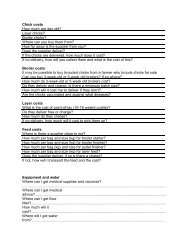AUSTRALIAN POULTRY CRC - Poultry Hub
AUSTRALIAN POULTRY CRC - Poultry Hub
AUSTRALIAN POULTRY CRC - Poultry Hub
- No tags were found...
You also want an ePaper? Increase the reach of your titles
YUMPU automatically turns print PDFs into web optimized ePapers that Google loves.
<strong>AUSTRALIAN</strong> <strong>POULTRY</strong> <strong>CRC</strong>FINAL REPORTProgram 1: Nutrition and gut physiologyProject No: 09-01PROJECT LEADER: Dr. Kapil Chousalkar,Associate professor Brian CheethamDATE OF COMPLETION: 16/12/2009Project No. 09-01Egg shell quality, with special focuson translucency and product safety1
© 2010 Australian <strong>Poultry</strong> <strong>CRC</strong> Pty LtdAll rights reserved.ISBN 1 921010 44 4Egg shell quality, with special focus on translucency and product safetyProject No. 09-01The information contained in this publication is intended for general use to assist publicknowledge and discussion and to help improve the development of sustainable industries.The information should not be relied upon for the purpose of a particular matter. Specialistand/or appropriate legal advice should be obtained before any action or decision is takenon the basis of any material in this document. The Australian <strong>Poultry</strong> <strong>CRC</strong>, the authors orcontributors do not assume liability of any kind whatsoever resulting from any person's useor reliance upon the content of this document.This publication is copyright. However, Australian <strong>Poultry</strong> <strong>CRC</strong> encourages widedissemination of its research, providing the Centre is clearly acknowledged. For any otherenquiries concerning reproduction, contact the Communications Officer on phone 02 67733767.Researcher Contact DetailsDr. Kapil ChousalkarSchool of veterinary and Animal sciences,Charles Sturt University,Wagga, NSWAustraliaPhone: 026933 4915Fax: 02 6933 2991Email: kchousalkar@csu.edu.auIn submitting this report, the researcher has agreed to the Australian <strong>Poultry</strong> <strong>CRC</strong>publishing this material in its edited form.Australian <strong>Poultry</strong> <strong>CRC</strong> Contact DetailsPO Box U242University of New EnglandARMIDALE NSW 2351Phone: 02 6773 3767Fax: 02 6773 3050Email: poultrycrc@une.edu.au.Website: http://www.poultrycrc.com.auPublished February 20102
Objectives of the present studyThe three objectives of this study were1 To study the ultrastructure of transluscent egg shells2 To determine the effect of egg shell translucency on the ability of bacteria suchas Salmonella and E coli to penetrate the egg shell.3 To investigate the presence of Mycoplasma synoviae in eggs and correlate itspresence with egg shell translucency.4
Chapter 1Ultra structure of translucent egg shellsFormation and Structure of Avian egg shellThe oviduct is divided into six distinguishable regions, infundibulum, magnum, isthmus,tubular shell gland, shell gland pouch, and vagina. Each region is morphologically differentand involved in some way in the process of egg formation, i.e. in the process of formation ofchalazae, thin and thick albumen, inner and outer shell membranes and a calcified shellaround the central mass of yolk (Gilbert, 1971). After spending 3-4 hours in the albumenforming regions of the oviduct (Infundibulum and magnum), the egg enters the isthmus andstays there for a short time. According to Draper et al. (1972), three parts of the oviduct,isthmus, tubular shell gland and shell gland pouch, are involved in the process of shellformation. The reticular formation of the isthmus starts depositing a continuous deposit offibrous layers around the rotating egg mass. In the granular isthmus, the substance of thecore and mantle of shell membrane fibres is deposited onto the egg. The process offabrication occurs inside the gland cells of the granular isthmus. The gland cells of thefunctioning oviduct contain electron dense material as a filament. The epithelial cells of thetubular shell gland produce and secrete the mammillary cores (Stemberger et al., 1977).Mammillary cores are seeding sites on which crystallization of the egg shell begins. Theintegrity of the mammillary region of the egg shell plays a vital part in egg shell quality.Mammillary cores are initial templates for the calcification of the egg shell, hence anychange in the morphology or composition of the mammillary cores could affect the egg shellstructure and quality. Mammillary caps, type A mammillae and type B mammillae areimportant components of the mammillary region (Brackpool, 1995). The mammillary capswith extensive contact with egg shell membrane are thought to hold the calcified egg shellmore firmly to the membranes which ultimately enhances shell strength (Solomon, 1991).The characteristic appearance of mammillary caps when they join closely to one another iscalled confluence.After formation of the mamillary cores, the egg enters the shell gland pouch with the shellmembranes still relatively loose and stays there for at least 20 hours. The shell gland pouchstarts pouring a watery secretion into the egg and this process is called “plumping” (Simkiss& Taylor, 1971). According to Simkiss and Taylor (1971), formation of egg shell pores maybe the effect of this continual secretion. The process of shell formation is initiated in theisthmus with the formation of the shell membranes and continues with the formation of themammillary cores in the tubular shell gland. The main part of shell mineralization occurs inthe shell gland pouch. Most of the calcium used for shell formation is derived from theblood although a small amount may be present in the shell gland pouch (Hohman andSchraer, 1966). The mitochondria of the gland cells in the shell gland pouch accumulatesufficient calcium ions. Epithelial cells play a major role in active transport of calcium fromthe blood stream. Simkiss and Tyler (1957) suggested that the mammillary core surroundedby sulphated protein is a chelating agent which removes calcium from the blood (chelationis the union between a metallic ion and a chelating molecule). The carbonate ions may thendisplace the chelating agent from calcium to form a calcium carbonate complex. Calcium5
secretion is thought to be under the control of hormones (Eastin and Spaziani, 1978).According to Simkiss & Taylor (1971), in the shell gland pouch during egg shell formation,calcium moves across the epithelial cells of the shell gland. The mitochondrial cells canstore a small quantity of calcium ions in the absence of calcification (Hohman and Schraer,1966). Calcium-binding protein, which is known to mediate the transport of calcium acrossthe intestinal wall, has been found in the avian shell gland pouch (Rabon et al., 1991). Dietscontaining 3.6 % calcium are the chief source of calcium during egg shell calcification.Moreover, the transport of calcium ions across the shell gland is also dependent on thehealthy reproductive status of the hen. Calcium ions migrate from the serosal layer to themucosal layer during the presence of an egg in the shell gland (Simkiss and Taylor, 1971).There is still controversy about the site of synthesis of shell pigment. Tamura et al. (1965)reported that epithelial cells are responsible for pigment secretion. However, according toBaird et al. (1975), the shell pigment protoporphyrin is derived from the blood. Thecompounds responsible for pigmentation are protoporphyrin, uroporphyrin andcoproporphyrin (Solomon, 1987).The cuticle is the last layer to be deposited on the egg. It is a waxy substance which plays animportant role in protecting the egg from bacterial penetration. Both apical and basal cellslining the pouch region are involved in this process and the cuticle is formed by non-ciliatedsecretory cells of the shell gland Solomon, (1991).Materials and methodsScanning electron microscopyEggs were candled and areas of translucency on egg shells were selected and marked with apencil. The structure of the eggshell was studied in four eggs with egg shell apexabnormality, egg shell translucency and unaffected eggs using SEM. The egg shell pieces ofapproximately one square centimeter were cut from the selected translucent areas. Aftersoaking the eggs shells in water, the egg shell membranes were manually removed. Theouter membrane was removed from the dry shell by ashing, using a Bio Rad RF plasmaBarrel Etcher PT 7150, as per described by Brackpool (1995). The mammillary region of theegg shell was examined for ultra structural characteristics as described by Brackpool (1995).Egg shell pieces from non translucent areas were also cut and processed for comparativeobservations. Observations regarding changes in mammilary cap arrangements, size, earlyfusion, late fusion depression, erosions, type A and B bodies were made and recorded.ResultsThe ultra structural appearance of the egg shells from the non translucent egg shells were inagreement with Brackpool (1995).The results regarding the appearance of translucent egg shells during candling are presentedin Plates (1.1 to 1.3).In the non translucent egg shells, there were no detrimental changes in the mammillary caps.Mammillary caps were of good quality with extensive attachment with the shell membrane.However, there was alignment of the mammille, where the mammillae appear to “line up”resulting in long continuous grooves between the cones (Roberts and Brackpool, 1994). Theultrastructure of alignment of mammillae is shown in plate 1.4 and 1.5. There was littlecuffing (additional calcium around the mammillary cones which appears to contribute to6
shell strength) in the translucent egg shells (Plate 1.6). Late fusion of the mammillary layerwas not recorded. Depression and erosion of mammillae were also observed.Plate 1.1: Egg shell with extensive translucencyPlate 1.2: Egg shell with translucent patch at thepointy end of the eggPlate 1.3: Egg shell without translucency.7
Plate 1.4. The ultrastructure of a translucent egg shell with alignment ofmammillaePlate 1.5. The ultrastructure of a normal egg shell.8
Plate 1.6. Mammillary caps of translucent eggs shells with poor cuffingPlate 1.7.Depression in the mammillary caps of translucent egg shell.9
Plate 1.8. Type B bodies in the translucent patch of egg shell (arrows)(Pitting) of the mammillae of the translucent egg shells was also recorded (Plate 1.7). TypeB bodies which are small spherical calcified bodies which have variable contact withmembrane fibres were also found in the translucent egg shell (Plate 1.8). Translucencycould be one of the egg shell pathology which results in changes in mammillary layerprobably due to the changes in the mamillary cores during the early phases of eggshellformation. Translucency ultimately has the potential to increase the incidence ofmicrocracks in egg shells.10
Chapter 2Effect of egg shell translucency on the ability ofbacteria such as Salmonella infantis and E coli topenetrate the egg shellIntroductionEggs produced in Australia are considered a medium to low risk food. The medium riskranking is mainly because of pathogens like Salmonella, E. coli, and also some otherenteropathogens. Although egg producers are diligent in fulfilling the legal obligations forthe production of safe food, the egg industry in Australia is often implicated in public healthrisks due to the frequent cases of food poisoning. Cage laying systems are the major sourceof whole shelled eggs for the supermarkets in Australia. Cage eggs are 54.3 per cent ofretail grocery sales followed by free range (38.6%) and barn eggs (7.1%). The operation andprofitability of barn and free range systems is dependent on the price differential paid forcage and alternate system eggs (Scott et al., 2005). The egg contents are an ideal growthmedia for microorganisms which are hazardous to human. Cooking can destroy or reducethe contaminants/ bacteria in eggs, although it is common practice to eat raw or lightlycooked egg in most parts of the world including Australia. The Australian poultry industryis considered to free from Salmonella enteritidis which is of major concern for the foodindustry all over the world. However, Salmonella typhimurium has been isolated from layerfarms in Australia (Arzey, 2008). Cox et al (2002) reported that Salmonella infantis was thepredominant pathogen in the Australian egg industry. It is recommended that eggs should beproperly cooked or pasteurized as cooking can destroy or reduce the contaminants/ bacteriain eggs (Davis and Breslin, 2003). However, even after cooking of an egg the persistence ofheat-stable toxin-producing microorganisms can pose a major threat to human health(Harbrecht and Bergdoll, 2006). The heat stable enterotoxins (STs) are small monomerictoxins that contain multiple cysteine residues whose disulfide bonds account for the heatstability of these toxins. ST-encoding genes (sta and stb) have been found on transposonsand plasmids. It has been reported that enterotoxigenic E coli (ETEC) express STb(Savarina et al. 1996; Yamamato and Echeverria 1996). Colicin V plasmids have beenreported in the avian pathogenic E coli and are associated with virulent properties likeincrease in serum survival and resistance to phagocytosis (Waters and Crosa, 1991, Vidottoet al., 1991). It is difficult for bacteria to move across an intact good quality egg shell.However, earlier reports indicate that small defects in the egg shell may provide the meansfor the predominant bacterial spp on the egg shell to penetrate the egg shell and move intothe egg contents (De Reu et al., 2006). Translucency is one of the egg shell pathology whichresults in irregular mammillary knobs probably due to the fusion of several mammillary11
cores during the early phases of eggshell formation. It is not clear whether translucency hasany role in potentiating the entry of bacteria into the egg contents. The risk that such eggspose to product safety is uncertain. In this study the unwashed eggs collected from the cagefront were tested for Salmonella and E. coli spp. All the E coli isolates were tested forenterotoxin and Colicin V gene. In this study the ultrastructure of translucent egg shells wasstudied and the influence of egg shell translucency on egg shell penetration and egg contentcontamination at different temperatures was also investigated.Materials and MethodsAn agar method described earlier by De Reu et al. (2006) was adapted to study the bacterialpenetration across the egg shell. Briefly, 180 fresh eggs were obtained from commercial Isabrown laying hens. Eggs were divided into two groups (n=90) in a 3 x 3 factorialarrangements. Internal contents of eggs obtained from this flock were tested. Each egg wasdipped into 70 % ethanol for 1 min to kill any bacteria on the outside of the shell and wasallowed to air dry in a biosafety cabinet. The egg contents were sucked out after making ahole and using a sterile syringe. Eggs were then washed with sterile phosphate bufferedsaline (PBS; pH 7.2) to remove all the albumen adhering to the membrane. Each egg wasthen filled with McConkeys agar. After hardening of the agar, the eggs were sealed withparaffin wax. An Sta positive E coli isolate which was isolated from the egg shell surface inour laboratory was selected for this study. The S. infantis strain was obtained from TheInstitute of Medical and Veterinary Science, Adelaide, Australia). Bacteria stored at -80 0 Cin 50% glycerol were plated on blood and incubated overnight at 37°C. A single colony wasthen inoculated and grown overnight at 37°C in Brian heart infusion broth (BHI; Oxoid).The broth was then diluted in PBS until 10 -6 dilution. Enumeration of viable bacteria wasperformed by serial dilution and plating 100 µl each solution out on McConkeys agar platesand incubation overnight at 37°C. Ten agar filled eggs were immersed for 1 minute in oneof three serial dilutions for E coli and Salmonella infantis (approximately 10 7 ; 10 5; 10 3 cellsper ml). After inoculation, agar filled eggs were kept at 4°C, room temperature and at 37°C.The eggs were aseptically opened in a biosafety cabinet after 72 hrs to inspect for growth ofcolonies. Colonies seen nearby the hole were not recorded as penetration. The shellmembranes and agar with colony growth were reinoculated onto Triple Sugar Iron agar(TSI; Oxoid) and incubated at 37°C for confirmation. All eggs were candled before fillingthem with agar and translucency was scored as 0 (no translucency), 1(mild translucency), 2(moderate translucency) and 3 (severe translucency).12
ResultsTable 1 and 2 shows the mean values with standard errors for all translucent egg shells (T),penetrated egg shells (Y) and non penetrated egg shells (N). The data are available forindividually selected E coli and S. infantis strains.Effects of egg shell translucency on E coli penetrationThere were no significant differences between the translucency score of total number ofinoculated egg shells used in different treatment groups (Table 1). At 37ºC, 6 out of 10 eggsinoculated in 10 7 cfu / ml were positive for egg shell penetration (Plate 2.1). 4 out of 10 eggsinoculated in 10 5 and 10 3 cfu / ml, were positive for egg shell penetration. Six out of 10 eggswere positive for bacterial penetration inoculated at the dose rate of 10 7 cfu and incubated atroom temperature (RT). 5 and 3 out of 10 eggs each were found positive for bacterialpenetration inoculated in 10 5 and 10 3 cfu respectively.Bacterial penetration was recorded in two out 10 eggs inoculated at 10 7 cfu and incubated at37ºC. For the eggs incubated at 37ºC, there were significant differences between egg shelltranslucencies of penetrated (Y) and non penetrated (N) egg shells inoculated in 10 7 and 10 3cfu. For the eggs incubated at RT, there were significant differences between egg shelltranslucencies of penetrated (Y) and non penetrated (N) egg shells inoculated in 10 3 cfu.The bacterial penetration was recorded along the translucent patches of the egg shell. (Plate2.2)Plate 2.1. Agar filed egg after bacterial penetration (arrow) and eggwith no penetration13
Score for extent of transluscencyPlate 2.2. Penetration of E coli across the translucent patches of theegg shell (arrow).Total egg shells Penetrated egg shells Non penetrated egg shells3.532.521.510.50Figure 2.1.10 7 10 5 10 3CFU per shellPenetration pattern of E coli across translucent and non translucent egg shellsat 37ºC.14
Score of extent of translucencyTotal egg shells Penetrated egg shells Non penetrated egg shells32.521.510.5Figure 2.2.010 7 10 5 10 3CFU per shellPenetration pattern of E coli across translucent and non translucent egg shellsat room temperature.15
Table 1: Egg shell translucency and egg shell penetration of E coli at 72 hrsCFU/ml Temperature Penetrated egg shells MeantranslucencyT es 10 1.9 ± 0.3710 7 37ºCY p 6 2.5 ± 0.37N p 4 1.0 ± 0.7010 5 37ºC10 3 37ºC10 7 RT10 5 RT10 3 RT10 7 4ºC10 5 4ºC10 3 4ºCT 10 1.5 ± 0.30Y 4 2.2 ± 0.25N 6 1.6 ± 0.88T 10 1.6 ± 0.34Y 4 2.5 ± 0.28N 6 1.5 ± 0.34T 10 1.6 ± 0.30Y 6 2.0 ± 0.25N 4 1.3 ± 0.57T 10 1.6 ± 0.40Y 5 1.7 ± 0.58N 5 0.8 ± 0.49T 10 1.3 ± 0.30Y 3 2.3 ± 0.30N 7 1.28 ± 0.28T 10 1.7 ± 0.36Y 2 2.0 ± 0.36N 8 1.75 ± 0.45T 10 1.7 ± 0.36Y 0 -N 10 -T 10 2.0 ± 0.36Y 0 -N 10 -T es- Total egg inoculatedY p - Penetrated egg shellsN p - Non-penetrated egg shellsCFU- Colony forming unit16
Effects of egg shell translucency on S. infantis penetrationThere were no significant differences between the translucency score of total egg shells (T)inoculated at different dilutions and incubated at various temperatures (Table 2). At 37ºC, 7out of 10 eggs inoculated in 10 7 cfu were penetrated by S. infantis and 4 out of 10 eggsinoculated in 10 5 and 10 3 cfu / ml, were penetrated by S. infantis. Seven out of 10 eggs werepositive for bacterial penetration which were inoculated at the dose rate of 10 7 cfu andincubated at room temperature. Four and three out of ten eggs each were found positive forbacterial penetration inoculated in 10 5 and 10 3 cfu respectively.Bacterial penetration was recorded in two out 10 eggs inoculated with 10 7 cfu and incubatedat 4ºC. S. infantis penetration was not recorded in any of the egg shells from the remainderof the treatments. For the eggs incubated at 37ºC, there were significant differences betweenegg shell translucencies of penetrated (Y) and non penetrated (N) egg shells inoculated in10 7 and 10 3 cfu. The bacterial penetration was recorded along the translucent patches of theegg shell (Plate 2.3).Plate 2.3. Penetration of S. infantis across the translucent patches of the egg shell(arrow)17
Score of extent of translucencyScore of extent of translucencyTotal egg shells Penetrated egg shells Non penetrated egg shells3.532.521.510.5010 7 10 5 10 3CFU per shellFigure 2.3. Penetration pattern of S. infantis across translucent and non translucent eggshells at 37ºC.2.5Total egg shells Penetrated egg shells Non penetrated egg shells21.510.5010 7 10 5 10 3CFU per shellFigure 2.4.Penetration pattern of S. infantis across translucent and non translucent egg shellsat room temperature.18
Table 2: Egg shell translucency and egg shell penetration of Salmonella infantis at 72hrsCFU/ml Temperature Penetrated egg shells Mean10 7 37ºC10 5 37ºC10 3 37ºC10 7 RT10 5 RT10 3 RT10 7 4ºC10 5 4ºC10 3 4ºCtranslucencyT es 10 1.5 ± 0.37Y p 7 2.1 ± 0.30N p 3 1.3 ± 0.88T 10 1.5 ± 0.30Y 6 2.0 ± 0.25N 4 1.0 ± 0.40T 10 1.6 ± 0.37Y 4 2.5 ± 0.50N 6 1.0 ± 0.36T 10 1.5 ± 0.34Y 7 2.0± 0.30N 3 1.1± 0.33T 10 1.2 ± 0.29Y 4 1.75 ± 0.47N 6 1.0 ± 0.36T 10 1.6 ± 0.30Y 3 1.6 ± 0.33N 7 1.4 ± 0.42T 10 1.6 ± 0.37Y 2 2.5 ± 0.50N 8 1.2 ± 0.36T 10 1.6 ± 0.34Y 0 -N 10 -T 10 1.9 ± 0.37Y 0 -N 10 -T es- Total egg inoculatedY p - Penetrated egg shellsN p - Non-penetrated egg shellsCFU- Colony forming unit19
Chapter 3Detection of Mycoplasma synoviae fromtranslucent and non translucent eggsIntroductionMycoplasmas are commensals and pathogens of various avian species, especially poultry.Mycoplasma synoviae (M. synoviae) may cause respiratory disease, synovitis, or may resultin a silent infection. M. synoviae are known to be transmitted vertically through eggs(Jordan 1979). M. synoviae strains vary in infectivity and virulence and infections maysometimes be unapparent. M. synoviae is considered to be the second most importantmycoplasma affecting chickens (Stipkovits & Kempf, 1996; Kleven, 2003). It causesrespiratory disease and subsequent condemnations due to airsacculitis in broilers andperitonitis and mortality in layers.. Earlier, the prevalence of egg M. synoviae antibody inegg yolk has been found to be the suitable approach for assessing the flock prevalence of M.synoviae infection in layer hens (Hagan et al., 2004). A British respiratory isolate of M.synoviae has been found to be vertically transmitted in broiler breeders (Macowan et al.,1984). Novel egg shell abnormalities characterised by altered shell surface, shell thinningand cracks were correlated with the Dutch strain of M. synoviae (Feberwee, 2009a & b).Polymerase chain reaction (PCR) has become a valuable diagnostic test to aid in thediagnosis of Mycoplasma infection. The primary advantage of PCR is that it is a rapid andsensitive method of direct detection of the organism's nucleic acid from the clinical samples.PCR has been developed for detection of Mycoplasma from tracheal and choanal-cleftswabs (Gracia et al., 2005). In the present study the attempts were made to set up a PCRreaction for the detection of M. synoviae from the egg vitelline membrane to study itsvertical transmission and also to study whether there is any correlation between translucentegg shells and the presence of M. synoviae in such eggs.Materials and MethodsDNA extraction from egg vitelline membraneApproximately 355 egg (230 eggs from laying hens and 125 turkey eggs) were tested for thedetection of M. synoviae. For DNA extraction from the vitelline membrane samples, an eggwas first cracked and drained of as much egg white as possible. The yolk was then placedin a sterile petridish and phosphate buffered saline (PBS) was added. The vitellinemembrane was then rinsed with sterile PBS to remove the adhering egg yolk and stored in1.5 ml microcentrifuge tubes at -20ºC. DNA extraction of the vitelline membranes orextraction from Mycoplasma cultures (Mycoplasma synoviae vaccine strain, Bioproperties)was performed using the Qiagen DNeasy Blood & Tissue Kit ® according to manufacturer’sinstructions. To each sample (about 0.2 ml), 180 μl of buffer ATL was added followed by20 μl of proteinase K. The samples were then incubated for up to three hours (usually20
equired about 1 ½ hours) at 56ºC in a waterbath. Samples were then vortexed and 200 μl ofBuffer AL was added. The samples were vortexed again, then 20 μl of ethanol was addedand samples again vortexed, The resulting solution was passed through a DNeasy Mini spincolumn and centrifuged at 13,000 rpm in a Clements 100 microcentrifuge for 1 minute. Theflow–through was discarded and the samples were then washed first with 500 μl of bufferAW1 and then 500 μl of buffer AW2 and again spun at 13,000 rpm for 1 minute. Followinga final centrifugation to remove residual buffer, 30 μl of Buffer AE was added and left for10 minutes. Samples were then spun at 13,000 rpm for 1 minute and the flow throughcollected and stored at -29ºC.Yolk interference testIt was found earlier that egg yolk had a greater negative effect on PCR amplification thanthe egg white (Xiaohua et al., 2007). Egg yolk is in close contact with the vitellinemembrane of the egg. Experiments were also conducted to test for the interference of eggyolk on the PCR reaction for the detection of M. synoviae. DNA was extracted from 1 mlAliquots of Mycoplasma vaccine as mentioned above. M. synoviae DNA was seriallydiluted up to 1x 10 -3 . One µl of serially diluted mycoplasma DNA was added to the swabstaken from the egg vitelline membrane which had yolk adhered to it. All the samples werethen tested for PCR. In another experiment, the egg vitelline membrane was washed insterile phosphate buffered saline (PBS) to remove as much yolk as possible. One µl ofserially diluted M. synoviae DNA was then added to the washed vitelline membrane. ThePCR was then carried out. Undiluted M. synoviae DNA extracted from a vaccine strain wasused as a positive control for PCR.Standard PCR reactionThe DNA extracted from the vitelline membrane was subjected to the PCR reaction usingthe primer sequences (Table 3.1) to confirm the presence of the desired fragment clonedearlier. Each reaction mixture contained 1 X reaction buffer (Fisher), 1.8 mM MgCl 2 , 200μM dNTPs, 1 uM of each primer, 1 U Taq polymerase, and 100 pg DNA template made upto 25 μl with MilliQ water. Samples were amplified using an Eppendorf® Mastercycler.DNA extracted from M.synoviae vaccine strain was used in every reaction as a positivecontrol. The details of primers used in the PCR reactions and size of amplified product aredescribed in Table 3.1. The PCR was performed in a thermal cycler using the followingtemperatures and times for 40 cycles: 94ºC for 30 sec, 55ºC for 120 sec, and 72ºC for 120sec. The final extension was at 72ºC for 300 sec. PCR products were purified using a PCRpurification kit (Promega Wizard ® PCR Preps DNA purification system) as permanufacturer’s recommendation. Twelve l of PCR product at a concentration of 200 ng/lwas sent to the DNA Sequencing Facility (Macquarie University), where reactions wereperformed and sequencing data were generated. The data were then forwarded by e-mailback to the sender for analysis.Scanning electron microscopyThe structure of the eggshell was studied in two eggs with egg shell apex abnormalities andin two unaffected eggs using scanning electron microscopy. The egg shells were processedas described before in materials and methods section of chapter 1.21
ResultsA 486 bp fragment of the 16S rRNA gene of M. Synoviae vaccine was amplified using nonquantitative PCR (standard PCR). The sequence of the amplicon matched the sequencepublished earlier by Volokhov et al. (2006), indicating that no errors were introduced duringPCR. The M. synoviae could not be detected by PCR in vitelline membrane which had eggyolk adhered to it, however M. synoviae was detected in vitelline membranes which werewashed in sterile phosphate buffered saline to remove the yolk contents. The egg vitellinemembrane of all 230 hen eggs tested negative for the presence of M. synoviae. Mycoplasmawas detected in the vitelline membrane of thirteen of the turkey eggs.Scanning electron microscopy of the egg shell with the egg shell apex abnormality revealedpoor mamillary caps with erosions and type B bodies (Plate 3.1). These abnormalities werenot recorded in the normal egg shells (Plate 3.2).Plate 3.1. Poor mammillary caps with type B bodies (arrow) inthe egg shell with abnormalities on the apex.22
Plate 3.2. Good quality mammilary caps in the egg shell with noabnormalities.DiscussionEgg shell quality has different meaning for various researchers. To the egg industry, a goodquality egg means the provision of an acceptable egg to the consumer. Egg shell quality canbe influenced by very many factors like age, strain of hen, temperature, disease (Roberts,2004). The mammillary region of the egg shell plays a very important role in egg shellquality and it has been recognised by various workers (Solomon, 1991, Brackpool, 1995).Mammillary cores are the initial templates of the calcified egg shell and hence any changesin the morphology of the egg shell quality can lead damage to the structure of the egg shell(Brackpool, 1995). In the present study, translucent egg shells had good quality mammillarycaps with extensive attachment with the shell membrane; however there was alignment ofthe mammillae where the mammillae appeared to “line up” resulting in long continuousgrooves between the cones. These groves in the egg shells are thought to lower theresistance of egg shells to bacterial penetration (Solomon, 1991). The ultrastructure ofaligned mammillae is shown in Plates 1.1 and 1.3. Cuffing is thought to be responsible forincreasing bacterial resistance to penetration and, in this study there was poor cuffing in thetranslucent egg shells. Depression and erosion of mammillary caps was also recorded in thetranslucent egg shells. Depressions or erosions are caused by accumulation of oviduct debrison the shell membrane prior to the egg shell calcification process. Pitting can reduce theshell’s resistance to bacterial penetration (Nascimento et al., 1992)Type B bodies, which are small spherical calcified bodies which have variable contact withmembrane fibres, were found in the translucent egg shells. Type B bodies are normally23
present in avian egg shells, although a large number of type B bodies can disrupt themammillary layer of the egg shell thereby potentiating the entry of bacteria (Nacimento etal., 1990).E. coli strains isolated from the egg shells were selected for the egg shell penetrationstudies. S. infantis strain was selected due to its importance to the Australian egg industry(Cox et al., 2002). In the present study, there was no significant difference between thetranslucency score of the total number of eggs shells used for bacterial penetration studywhich indicates equal distribution of translucent eggs amongst the treatment groups. Cox etal. (2002) further observed that S. infantis inoculated onto the surface of the egg couldpenetrate the egg shell and had the potential to grow within the contents of the egg. Ourfindings regarding the penetration of S. infantis strain across the egg shell are in agreementwith Cox et al., (2002)., although the translucency score was significantly higher inpenetrated egg shells compared to non penetrated egg shells. Our finding regarding thepenetration of E coli across the translucent egg shell cannot be compared to those of otherworkers, owing to a dearth of literature in this area. At 4ºC, only two egg shells werepenetrated at high dose rate of the bacterial inoculums. The current finding highlights theimportance of storing eggs appropriately throughout the supply chain. The regime oftemperature variation, along with poor egg shell quality, could facilitate bacterialpenetration across the egg shell. Earlier, Oliveira and Silva (2000) and Aydin et al (2004)reported the presence of viable bacterial cells on the shells of intact eggs at refrigerationtemperatures.Board and Tranter (1995) reported that the extent of contamination of hatching eggs was inthe range from 2 up to 7 log (10 2 up to 10 7 ) colony forming units (CFU) per eggshell. In eggwashing experiments, Knape et al. (2002) and Favier et al. (2000), reported an averageinitial eggshell contamination of 6.33 and 4.55 log CFU/ eggshell respectively.In the current experiment, although the dose of bacterial inoculation was very high, it waswithin the normal contamination range described in earlier studies by Board and Tranter(1995) and Knape et al. (2002). However during this study, eggs were washed in 70%ethanol prior to external inoculation which may have damaged the cuticle, reducing itsprotective properties. There is still the possibility that pathological lesions in egg shells likecuffing, type B bodies and depressions, seen in the transluscent egg shells, could havepotentiated the entry of bacteria across the egg shell. The translucent egg shell surface canincrease the likelihood of internal contamination of eggs. In this study, however, thebacterial contamination of the egg shell was not quantified and further research is needed inthis area.A Dutch strain of M. synoviae has been found to be one of the factors responsible forformation of translucent eggs (Feberwee et al., 2009 a &b). During earlier studies, althoughM. synoviae was isolated from the oviduct without any histopathological lesions, attemptswere not made to detect the M. synoviae from the egg vitelline membrane. There is littleinformation about the effects of Australian strains of M. synoviae on the oviduct andpossibility of the formation of translucent egg shells or egg shells with apical abnormalities.Hagan et al. (2004) reported that screening of antibodies against M. synoviae in eggs byELISA is a suitable method for prevalence studies, so such an approach could be usedduring future investigations.In the present study, Mycoplasma was not detected either in translucent or non translucentegg shells from poultry, however it would be hard to correlate such findings without doingfurther detailed investigation regarding the study the effects of Australian strains of M.synoviae on the oviduct and egg quality of mature laying hens. This could be performed by24
studying the histopathology of the oviduct andisolation/detection of Mycoplasma from theoviduct and eggs.It was also found that egg yolk interferes in the PCR reaction during the detection ofMycoplasma. This finding is in agreement with earlier report by (Xiahoua et al., 2007) whoreported the similar findings during detection of Castor Toxin Contamination in eggs.Implications of this study and further research in this area1 In this study the ultrastructure of the translucent egg shell was studied. Littleinformation is available regarding the factors responsible for the formation of eggshell translucency and further research is required to study whether egg shelltranslucency is related to nutritional, managemental or any disease factors. Thepresent study was conducted using small sample size and quantitative studies areessential using large number of samples.2 In the second experiment, the effects of translucency on the ability of food bornepathogens like Salmonella infantis and E coli were studied. Egg shell translucency isresponsible for bacterial penetration and there was significant correlation betweenthe egg shell translucency and egg shell penetration by S. infantis and E coli. Boththe strains of bacteria were able to penetrate the translucent egg shells, even at verylow dose. The penetration, however, was reduced in both translucent and nontranslucent eggs at 4ºC which highlights the importance of storage of eggs atrefrigeration temperature.3 M. synoviae was not isolated from either translucent or non translucent eggs fromchickens in the present study; however further studies are required regarding thesimultaneous detection and isolation of Australian strains of M. synoviae fromoviduct. As this organism has been associated with eggshell defects, it is essential toestablish whether or not this organism can be detected from egg contents up to aparticular period after infection. In Australia, M. synoviae has been isolated from thechickens affected with infectious synovitis (Morrow et al., 1990). M. synoviae hasalso been isolated from the egg yolk of embryonated eggs from ducks (Bencina etal., 1988). Considering the negative effects of egg yolk on the PCR reaction, it isessential to carry out a pre-enrichment procedure before carrying out PCR reactionfor detection of Mycoplasma from egg vitelline membrane or egg yolk. It is alsoessential to study the possibility of formation of translucent eggs due to synergisticeffects of Australian uterotropic strains of infectious bronchitis virus and M.synoviae in the oviduct of mature laying hens. This is particularly important asAustralian strains of infectious bronchitis virus can cause negative effects on egginternal quality, shape index and shell colour.25
AcknowledgementsI would like to thank Associate Professor Julie Roberts, for her scientific advice during thisstudy. Julie’s contribution was vital and critical for the completion of this project I wouldlike to thank Ms. Megan Sutherland and Ms. Pam Flynn for their technical support. I wouldalso like to acknowledge Mr. Rowly Horne for his valuable suggestions. I would like tothank Dr. Ben Wells, Dr. Peter Scott, Mr. Bede Burke, Mr. Chris Holland and Mr. NoelKratzmann and all egg producers for providing egg samples for this study. I would also liketo acknowledge Dr. Michael Heuzenroeder and Dianne Davos from Institute of Medical andVeterinary Sciences, Adelaide for providing Salmonella infantis strain for this study.Thanks to Dr. Tim O’Shea for having me at his house during my stay in Armidale forcompletion of one of the experiment for this project.ReferencesArzey, G. (2008). Persistence of Salmonella in layer farms and implications to food bornerisks and risk interventions. Proceedings of World’s <strong>Poultry</strong> Conference 2008.Brisbane, Australia. CD Rom.Baird, T., Solomon, S. E. & Tedstone, D. R. (1975). Localisation and characterization ofegg shell porphyrins in several avian species. British <strong>Poultry</strong> Science 16, 201-208.Bencina D., Tadina, T., Dorrer, D. (1988). Natural infection of ducks with Mycoplasmasynoviae and Mycoplasma gallisepticum and mycoplasma egg transmission. AvianPathology, 17, 441-449.Board, R.G. and Tranter, H.S. (1995). The microbiology of eggs. Egg science andtechnology. W.J. Stadelman, Cotterill, O.J. (Eds.). New York, Food Products Press -The Haworth Press, Inc.: 81-104.Brackpool, C. E. (1995). Egg shell ultrastructure as an indicator of egg shell quality inlaying hens. PhD Thesis. Armidale: University of New England.Cox, J.M., Woolcock, J.B. and Sartor, A.L. (2002). The significance of Salmonella,particularly S. Infantis, to the Australian egg industry. Report submitted to RuralIndustries Research and Development Corporation.De Reu K., Grispeerdt, K., Messens, W., Heyndricks, M., Uyttendaele, M., Debevere, J.and Herman, L. (2006). Egg shell factors influencing egg shell penetration andwhole egg contamination by different bacteria including salmonella enteritidis.International Journal of Food Microbiology. 112: 253-260.De Reu K., Messens, W., Heyndricks, M., Rodenburg, T.B. Uyttendaele, M. andHerman, L. (2008). Bacterial contamination of table eggs and the influence ofhousing systems. World’s poultry science Journal. 64: 5-19.Draper, M. H., Davidson, M. F., Davidson, G. & Johnston, H. S. (1972). The finestructure of the fibrous membrane forming region of the oviduct of domestic fowl.Quarterly Journal of Experimental Physiology 57, 297-309.26
Eastin, J. W. C. & Spaziani, E. (1978). On control of calcium secretion in the avian shellgland (Uterus). Biology of Reproduction 19, 493-504.Feberwee A., Morrow, C.J., Ghorashi, S.A., Noormohammadi, A.H., Landman W.J.(2009a). Effect of a live Mycoplasma synoviae vaccine on the production of eggshellapex abnormalities induced by a M. synoviae infection preceded by an infection withinfectious bronchitis virus D1466. Avian Pathology, 38, 333-340.Feberwee A, de Wit JJ, Landman WJ. (2009b). Induction of eggshell apex abnormalitiesby Mycoplasma synoviae: field and experimental studies. Avian Pathology, 38, 77-85.Gilbert (1971). The egg in reproduction in, Physiology and biochemistry of domestic fowl.Vol 3, Ed D.J. Bell and B.M. Freeman. Acedemic press London. Pages 1401-1410.Hagan, J.C., Ashton, N.J., Bradbury, J.M., Morgan, K.L. (2004). Evaluation of an eggyolk enzyme-linked immunosorbent assay antibody test and its use to assess theprevalence of Mycoplasma synoviae in UK laying hens. Avian Pathology, 33, 93-97.Harbrecht, D.F. and Bergdoll, M.S. (2006). Staphylococcal enterotoxin B production inhard-boiled eggs. Journal of food science. 45: 307-309.Hohman, W., and Schraer, H. (1966). Intracellular distribution of calcium in the mucosaof avian shell gland. Journal of cell biology, 30, 317-331.Jordan, F.T.W. (1975). Avian mycoplasma and pathogenecity- A review. Avian Pathology,4, 165-174.Knape, K.D., Chavez, C., Burgess, R.P., CoufalL, C.D. and Carey, J.B. (2002).Comparison of eggshell surface microbial populations for in-line and off-linecommercial egg processing facilities. <strong>Poultry</strong> Science, 81: 695-698.Morrow, C. J., Bell, I.G., Walkers, S.B.,Markham, P.F., Thorp, B.H., Whithear, K. G.(1990).Isolation of Mycoplasma Synoviae from chickens. Australian VeterinaryJournal, 67, 121-124.Nascimento, V.P., Cranstoun, S., Solomon, S.E. (1992). Relationship between shellstructure and movement of Salmonella enteritidis across the eggshell wall. British<strong>Poultry</strong> Science, 33, 37-48.Rabon, H. W., D. A. Roland and A. J. Clark, (1991). Uerine clciurn-binding proteinactivity of nonlaying hens and hens laying hard-shelled or shell-less eggs. <strong>Poultry</strong> Science.70:2280-2283.Roberts, J.R., and Brackpool, C.E. (1994). The ultrastructure of avian egg shells. <strong>Poultry</strong>Science Reviews, 5, 45-272.Roberts, J. R. (2004). Factors affecting egg internal quality and egg shell quality in layinghens. Journal of <strong>Poultry</strong> science, 41, 161-177.Savarina, S.J., Mc Veigh, Watson J, Motina, J., Cravioto, A., Echeverria, P., Bhan,M.K., Levine, M.M., Fasano, A. (1996) Enteroaggregative Escherichia coli heatstableenterotoxin is not restricted to enteroaggregative Escherichia coli. Journal ofInfectious Diseases. 173:1019–1022.Scott, P.C., Turner, A., Bibby, S. and Chamings, A. (2005). Structure and Dynamics ofAustralian commercial <strong>Poultry</strong> and Ratite industries. A report submitted to TheDepartment of Agriculture, Fishery and Forestry.27
Simkiss, K. & Tyler, C. (1957). A histochemical study of the organic matrix of hen eggshells. Quarterly Journal of Microscopical Science 98, 19-28.Simkiss, K. & Taylor, T. G. (1971). Shell formation. In Physiology and biochemistry ofdomestic fowl, pp. 1331-1342. Edited by B. M. Freemman & D. J. Bell. London:Academic press.Solomon, S. E. (1975). Studies of Isthamus region of domestic fowl. British <strong>Poultry</strong> Science16, 255-258.Solomon, S. E. (1987).Egg shell pigmentation In: Egg quality- Current problems and recentadvances. In <strong>Poultry</strong> science Symposium. eds R. G. Wells & C. G. Belyavin.Butterworth & Co Ltd, London. pp 147-157.Solomon, S. E. (1991). The ovary and oviduct in, Egg and egg shell quality. London: WolfePublishing Limited. London. pp 11-32Stemberger, B. H., Mueller, W. J. & Leach, R. M. (1977). Microscopic study of theInitial stages of egg shell calcification. <strong>Poultry</strong> Science 56, 537-543.Vidotto, C.M., Goes, C.R., Taque, J., Tanuri, A. and Santos, D.S. (1991). Cloning ofstructural genes for colicin V and their invasive role in pathogenicity of invasive Ecoli. Brazilian Journal of Genetics.14: 1-8.Waters, V.L. and Corsa, J.H. (1991). Colicin V virulence plasmids. MicrobiologicalReviews. 55: 437-450.Yamamato, T. and Echeverria, P. (1996). Detection of the enteroaggregative Escherichiacoli heat-stable enterotoxin 1 gene sequences in enterotoxigenic E. coli strainspathogenic for humans. Infection and Immunology. 64:1441–1445.Xiaohua H.E., Carter, J.M., Brandon, D.L., Cheng, W.L., and Mckeon, T.A. (2007).Application of a Real Time Polymerase Chain Reaction Method to Detect CastorToxin Contamination in Fluid Milk and Eggs. Journal of Agriculture and FoodChemistry, 55: 6897-6902.28
Plain English Compendium SummaryProject Title:<strong>Poultry</strong> <strong>CRC</strong> ProjectNo.:Researcher:Organisation:Phone: 02 6933 4915026733 1995Fax:Email:Project OverviewBackgroundResearchEgg shell quality, with special focus on translucency andproduct safety<strong>CRC</strong> 01/09Dr. Kapil Chousalkar a , and Associate Professor Brian Cheetham ba School of Veterinary and Animal sciences,Charles Sturt University,Wagga, NSWAustraliab School of Science and TechnologyThe University of New England,Armidale, NSWAustraliakchousalkar@csu.edu.auIn this project, egg shell translucency was studied and defined at a microscopiclevel. The ability of bacteria such as E coli and Salmonella to penetratetranslucent egg shells was studied. A polymerase chain reaction was set up andstandardised for rapid detection of Mycoplasma synoviae from the eggs to studywhether their presence is responsible for formation of translucent eggs.During egg quality analysis of eggs collected from various farms acrossAustralia AECL Project (UNE/AECL 86), translucent eggs and microcrackswere observed. The translucency in the egg shells appeared to be irrespective ofhen age. The role of the phenomenon known as “translucency” is still poorlydefined. In addition, it is not clear whether translucency has any role inpotentiating the entry of bacteria into the egg contents. The risk that such eggspose to product safety is uncertain. The proposed project was conducted todefine translucency at the ultrastructural level and also to evaluate the extent towhich these features increase the likelihood of bacteria penetrating the egg shell.There is little information about the factors responsible for formation translucenteggs. There is a possibility that nutritional, managemental or infectious agentcould be responsible for the formation of translucent eggs. Earlier, a Dutch strainof M. synoviae was found to be one of the factors responsible for egg shelltranslucency (Feberwee et al., 2009a &b), however there is little informationavailable regarding the positive correlation between Australian strains ofM.synoviae and egg shell translucency. In the present study translucent and nontranslucent eggs were tested for the presence of M.synoviae.Egg shell translucency was studied at ultrastructural level by scanning electronmicroscopy. The ability of E coli and Salmonella to penetrate egg shells wasstudied by the agar moulding technique (filling eggs with agar and the dippingthem into bacterial suspension). The translucent and non translucent eggs weretested using a polymerase chain reaction to detect Mycoplasma synoviae.Project Progress CompletedImplications 1 In this study, the ultrastructure of translucent egg shells was studied.Little information is available regarding the factors responsible for theformation of egg shell translucency and further research is required tostudy whether egg shell translucency is related to nutritional,managemental or any disease factors.2 In the second experiment, the effects of translucency on the ability offood borne pathogens like Salmonella and E coli were studied. The eggshell translucency is responsible for bacterial penetration and there was29
Publicationssignificant correlation between egg shell translucency and egg shellpenetration by S. infantis and E coli. Both the strains of bacteria wereable to penetrate the translucent egg shells even at very low dose. Thepenetration however was hindered in both translucent and nontranslucent eggs at 4ºC which highlights the importance of storage ofeggs at refrigeration temperature.3 M. synoviae was not isolated from either translucent or non translucenteggs from chickens in the present study; however further studies arerequired regarding the simultaneous detection and isolation ofAustralian strains of M. synoviae from oviduct. As this organism hasbeen associated with eggshell defects, it is essential to establish whetheror not this organism can be detected from egg contents up to particularperiod after infection. In Australia M. synoviae has been isolated fromthe chickens affected with infectious synovitis (Morrow et al., 1990).M. synoviae has also been isolated from the egg yolk of embryonatedeggs from ducks (Bencina et al., 1988). Considering the negativeeffects of egg yolk on PCR reaction, it is essential to carry out preenrichment procedure before carrying out PCR reaction for detection ofMycoplasma detection from egg vitelline membrane or egg yolk. It isalso essential to study the possibility of formation of translucent eggsdue to synergistic effects of Australian uterotropic strains of infectiousbronchitis virus and M. synoviae in the oviduct of mature laying hens.This is particularly important as Australian strains of infectiousbronchitis virus can cause negative effects on egg internal quality,shape index and shell colour.In preparation30



